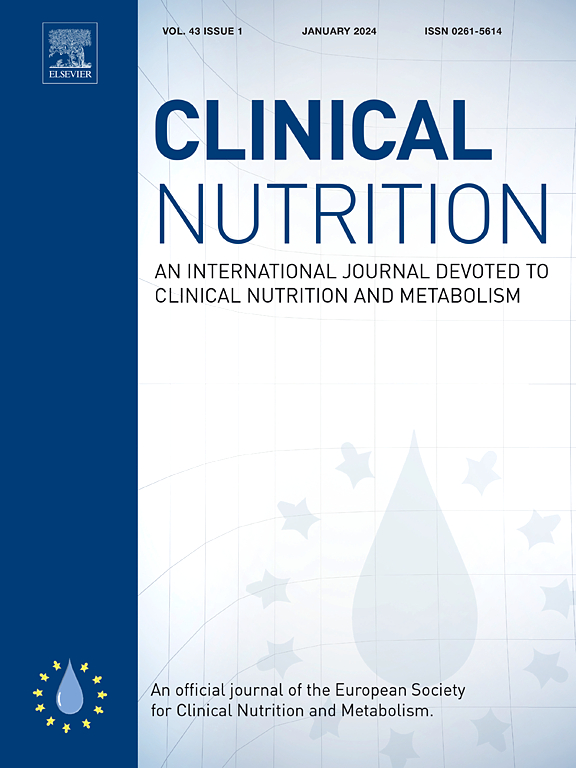Synbiotics protected radiation-induced tissue damage in rectal cancer patients: A controlled trial
IF 6.6
2区 医学
Q1 NUTRITION & DIETETICS
引用次数: 0
Abstract
Background & aims
Colorectal cancer (CRC), particularly rectal cancer, often requires neoadjuvant radiotherapy (RT) as part of its treatment plan. Although effective, RT can cause significant gastrointestinal side effects. Because the onset of RT-induced tissue injury can be anticipated, there is an opportunity to apply preventive measures before the damage occurs. This study aimed to assess whether prebiotic and synbiotic interventions could mitigate RT-induced gut injury by modulating the mucosa-associated microbiota, reducing inflammation, and enhancing gut barrier function in patients undergoing RT for rectal cancer.
Methods
Thirty patients with rectal adenocarcinoma scheduled for preoperative short-term RT (5 × 5 Gy) were divided into three groups: a control group (Ctrl), a prebiotic group (Fiber) receiving oat bran, and a synbiotic group (Synbiotics) receiving oat bran with L. plantarum HEAL19 and blueberry husks. The study products were administered daily for two weeks, starting one week before RT. Blood, faecal, and biopsy samples were collected before and after RT to evaluate inflammatory markers, intestinal permeability, histopathological changes, and mucosa-associated microbiota.
Results
The Fiber and Synbiotics groups exhibited a significant reduction in white blood cell counts following RT (p = 0.01 for both), whereas the Ctrl group did not demonstrate a significant change. However, there was no significant difference in the magnitude of change in white blood cell counts among the three groups (p = 0.12). Histopathological analysis revealed that the Synbiotics group had reduced inflammation and fibrosis compared to the Fiber and Ctrl groups. Although RT reduced bacterial diversity overall, the Synbiotics group preserved a greater proportion of bacterial species, experiencing only a 25.1 % reduction compared to a 55.4 % reduction in the Fiber group.
Conclusion
Synbiotic interventions may protect rectal mucosa by reducing inflammation and modulating mucosa-associated microbiota. The effects were primarily localized to the tissue, reflecting the short-term duration of treatment. While immediate benefits were observed, longer-term interventions should be explored to reduce systemic inflammation.
合生剂对直肠癌患者辐射诱导的组织损伤的保护:一项对照试验
背景,结直肠癌(CRC),尤其是直肠癌,通常需要新辅助放疗(RT)作为其治疗计划的一部分。虽然有效,但RT会引起明显的胃肠道副作用。由于可以预见到rt诱导的组织损伤的发生,因此有机会在损伤发生之前采取预防措施。本研究旨在评估益生元和合成干预是否可以通过调节粘膜相关微生物群、减少炎症和增强直肠癌接受RT治疗患者的肠道屏障功能来减轻RT诱导的肠道损伤。方法30例直肠癌患者术前短期放射治疗(5 × 5 Gy)分为3组:对照组(Ctrl)、益生元组(Fiber)和合成组(Synbiotics),燕麦麸皮加植物乳杆菌HEAL19和蓝莓皮。研究产品每天服用两周,从RT前一周开始。RT前后收集血液、粪便和活检样本,以评估炎症标志物、肠通透性、组织病理学变化和粘膜相关微生物群。结果纤维组和合成组在RT后白细胞计数明显减少(p = 0.01),而Ctrl组没有明显变化。但三组患者白细胞计数变化幅度差异无统计学意义(p = 0.12)。组织病理学分析显示,与纤维组和对照组相比,合成组的炎症和纤维化减少。虽然RT总体上减少了细菌多样性,但合成菌组保留了更大比例的细菌种类,仅减少了25.1%,而纤维组减少了55.4%。结论综合干预可能通过减少炎症和调节粘膜相关菌群来保护直肠黏膜。效果主要局限于组织,反映了治疗的短期持续时间。虽然观察到直接的益处,但应探索长期干预措施以减少全身性炎症。
本文章由计算机程序翻译,如有差异,请以英文原文为准。
求助全文
约1分钟内获得全文
求助全文
来源期刊

Clinical nutrition
医学-营养学
CiteScore
14.10
自引率
6.30%
发文量
356
审稿时长
28 days
期刊介绍:
Clinical Nutrition, the official journal of ESPEN, The European Society for Clinical Nutrition and Metabolism, is an international journal providing essential scientific information on nutritional and metabolic care and the relationship between nutrition and disease both in the setting of basic science and clinical practice. Published bi-monthly, each issue combines original articles and reviews providing an invaluable reference for any specialist concerned with these fields.
 求助内容:
求助内容: 应助结果提醒方式:
应助结果提醒方式:


